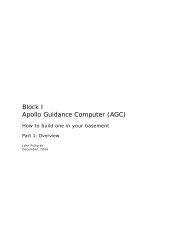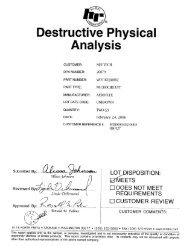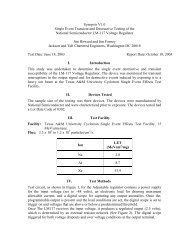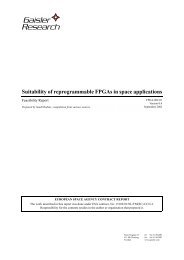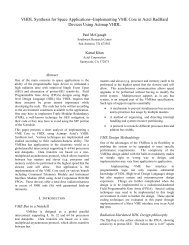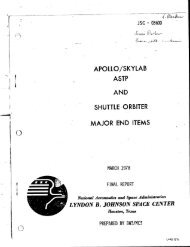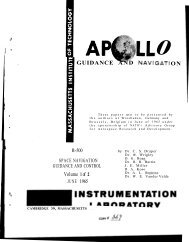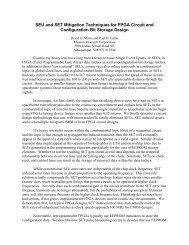Application and experience of CAN as a low cost OBDH bus system ...
Application and experience of CAN as a low cost OBDH bus system ...
Application and experience of CAN as a low cost OBDH bus system ...
Create successful ePaper yourself
Turn your PDF publications into a flip-book with our unique Google optimized e-Paper software.
3 Future Work<br />
3.1 Protocols<br />
<strong>CAN</strong>-SU h<strong>as</strong> been tried <strong>and</strong> tested over a large number <strong>of</strong> missions <strong>and</strong> h<strong>as</strong> been proved<br />
ro<strong>bus</strong>t. It does not however make the most <strong>of</strong> <strong>CAN</strong>. The use <strong>of</strong> 29 bit identifiers could<br />
incre<strong>as</strong>e the amount <strong>of</strong> data available per telemetry request <strong>and</strong> also make use <strong>of</strong> the RTR<br />
bit <strong>and</strong> other features unavailable through <strong>CAN</strong>-SU. Future work on <strong>CAN</strong> protocols at<br />
SSTL could also concentrate on <strong>CAN</strong>Open.<br />
3.2 Hardware<br />
SSTL is currently looking at the latest generation <strong>of</strong> 8-bit microcontrollers to replace the<br />
current infineon device. Initials tests <strong>of</strong> a Microchip PIC device have looked promising with<br />
the 3.3V core providing a significant power saving. The processor can also be clocked up<br />
to 40MHz providing up to 3.5MIPS if required (compared to the infineons 1MIPS).<br />
As SSTL moves out <strong>of</strong> purely LEO missions, the need for more ro<strong>bus</strong>t, radiation tolerant<br />
<strong>system</strong>s incre<strong>as</strong>es. The next generation <strong>of</strong> Rad<strong>CAN</strong> is being developed <strong>as</strong> a System on a<br />
chip solution (SoC), integrating VHDL IP cores for a micro-controller, <strong>CAN</strong> core, memory<br />
<strong>and</strong> EDAC in a single FPGA <strong>as</strong> shown in figure 7. The current FPGA b<strong>as</strong>eline is the<br />
million gate radiation tolerant version <strong>of</strong> the Actel AX.<br />
> 20Kbytes<br />
SRAM from<br />
Internal AX<br />
Resources<br />
16:8 Cyclic<br />
EDAC<br />
SSTL IP Core<br />
Boot Code<br />
Stored <strong>as</strong><br />
LUT<br />
8051<br />
Commercial<br />
IP Core<br />
Figure 7 – IP cores to replace Rad<strong>CAN</strong><br />
Glue<br />
Hurricane<br />
ESA <strong>CAN</strong><br />
IP Core<br />
ADC<br />
Interface<br />
GPIO<br />
& Custom<br />
Interfaces<br />
Actel RTAX1000S<br />
External ADC <strong>and</strong><br />
Analog multiplexers<br />
Are still required<br />
IO can be configured<br />
As LVDS or LVTTL<br />
For applications not requiring microcontroller functionality, Rad<strong>CAN</strong> Lite is being<br />
developed <strong>as</strong> just the <strong>CAN</strong> core with a simple state-machine for telemetry <strong>and</strong><br />
telecomm<strong>and</strong> services. This design would be targeted at the smaller <strong>and</strong> cheaper Actel<br />
RTSXA range <strong>of</strong> FPGAs.




